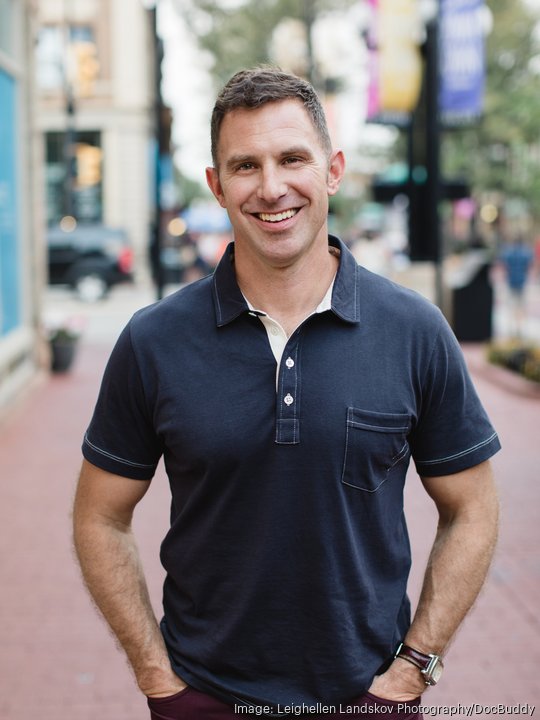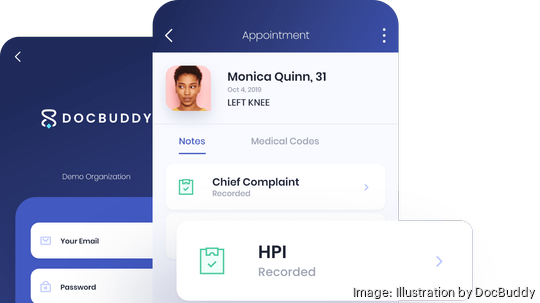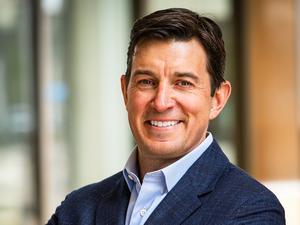
When it comes to using advanced technology, the health care industry is often late to adopt new tools, which can create a very manual and administrative-heavy workflow.
A Greenwood Village-based company, which raised a $1.84 million seed round last week, aims to solve this problem for health care workers by offering optimized and streamlined workflows that help ease the administrative burden of documentation and moving data.
Founded in 2014, DocBuddy began as a mobile solution for doctors to create and access patients’ electronic medical records and included a voice-to-text service. Having since expanded into an interoperable workflow tool, the cloud-based platform is now used by medical providers, surgeons, hospitals and clinical staff.
Today’s version of DocBuddy, which can be accessed through a mobile app or web-based portal, allows medical professionals and their staff to access and document patient data at the point of care, whether that’s during a telehealth appointment, at-home hospice visit or at a surgery center.
DocBuddy CEO and founder Andy D’Agostino, who worked on the sales side of the health care industry for 12 years before launching the company, said his mission is to save doctors, providers and health care workers’ time. Two years after DocBuddy launched, a study by the Annals of Internal Medicine (a branch of the American College of Physicians) said doctors were wasting two-thirds of their time on paperwork.
"DocBuddy’s ultimate goal from the beginning was to give time back to the provider and to everyone involved in the health care ecosystem,” D’Agostino said. “We believe time equals everything, professionally and personally. … Our slogan is ‘time for life.’”

The pandemic’s impact
D’Agostino said the first six years of the company’s life were spent “painting the big picture” and showing the need for a digital workflow solution. Once that was done, D’Agostino hired developers to build the platform.
“We were early to the market, started gaining a lot of traction in really 2018-19, and then 2020 hits,” he said. “Health care kind of treads water for the next two to three years.… What we’re seeing now [in terms of demand], I thought we were going to see in 2021.”
While the Covid-19 pandemic may have slowed DocBuddy’s growth, it didn’t stop it. The company still had customers using the platform, but not many new users were joining because health care professionals weren’t willing to innovate, said Phil Beaver, a DocBuddy investor, founding board member and the company's chief data officer.
The pandemic solidified this workflow problem because health care employees were put under a lot of pressure and are now leaving the industry, D’Agostino said.
“You can’t speed up health care technology changes and we’ve managed to remain patient for those tech demand changes to happen,” D’Agostino said. “We are at a tipping point with a lot of those changes now in the post-pandemic world.”
Funding and beyond
DocBuddy’s recent $1.84 million seed round comes at a post-money valuation of roughly $62 million, according to D’Agostino. It also brings the company’s total capital raised to approximately $4.13 million, all of which has come from angel investors rather than venture capital firms.
D’Agostino said the company hasn’t had to raise a lot of capital because it’s been lean — the team doesn’t have a physical office and D’Agostino didn’t pay himself for the first six years. The company has grown strategically. D’Agostino said he and the DocBuddy team knew they couldn’t speed up innovation in the health care market, but wanted to be the catalyst of the change when it did happen.
“Andy has been very flexible in terms of understanding what the market wants and moving in that direction without letting the market give us whiplash, without chasing every silly idea that someone comes up with,” Beaver said. “He’s been very focused. But when he realized we have more than a voice-to-text tool and EMR [electronic medical records] tool, we have a workflow tool, it really changed the game for a lot of our customers.”
DocBuddy is currently used by 60 or 70 health care organizations across the country, each with anywhere from 20 to 70,000 providers. Its customers include SCA Health, one of the largest providers of outpatient surgery in the U.S., and facilities operator HCA Healthcare. But, according to D’Agostino, DocBuddy isn’t at scale yet.
“We’re at a place right now where we’re getting ready to scale, big time,” he said. "Right now, we’ve got a footprint all over the country, but we’re not at scale yet. That’s why I raised a couple of million bucks because we're getting ready for that and we're getting flooded right now [with requests].”
DocBuddy plans to roll out three partnerships with large health care providers later this year, giving the company access to more than 100,000 providers. The company is expected to be cash flow positive early next year, according to D’Agostino.
To prepare for this growth, DocBuddy will hire four account managers and five developers in the next six months. The company currently has 14 employees and a contract team of engineers.







